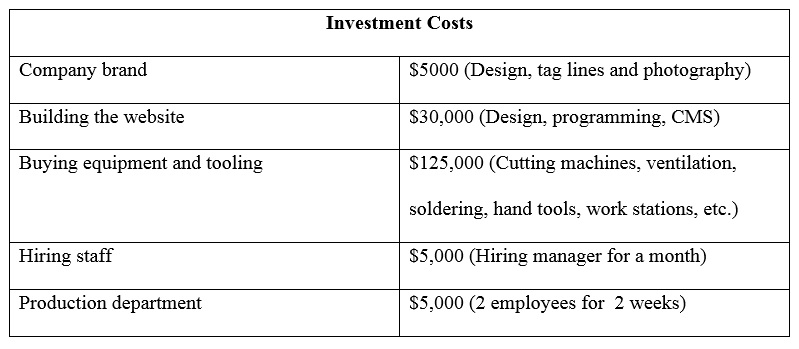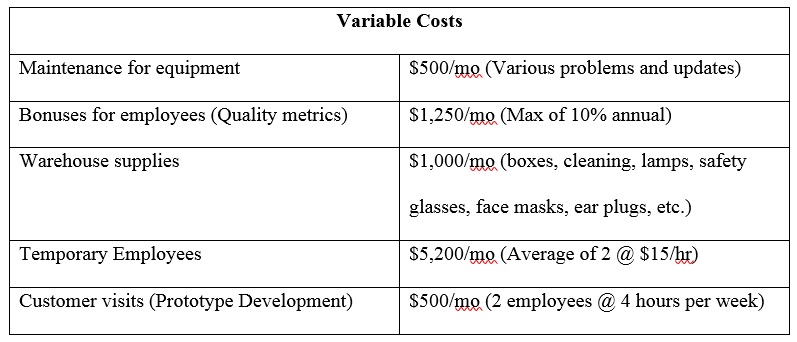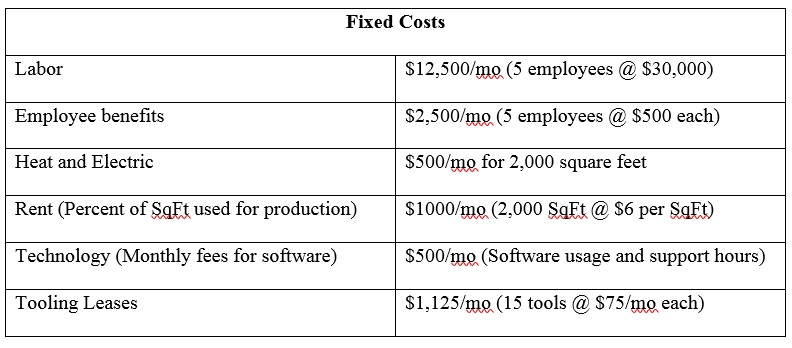 |
Chris Bell | 'The man on top of the mountain didn't fall there.' |
| - Vince Lombardi |
 |
Chris Bell | 'The man on top of the mountain didn't fall there.' |
| - Vince Lombardi |
SNHU - MBA-560 - Marketing and Strategy
Written by: Chris Bell - August, 2017
WesBell had an established website bringing in more than a million dollars in revenue each year and could've chosen to add a few locations of distribution plants, but instead started offering cutting services that were labor and machine intensive to their current customer base. My idea was to introduce the services concept broadly and quickly by adding the functionality to their website and by marketing it in all of their company's branding and literature. They now offer services from a menu on their website that you can add to cart as if it were a product (Cut this wire order to 6 inch pieces).
The business wide procedures that were created to measure the success of the services menu were to compare the total fixed and variable costs of the project, obtain feedback from customers, review website analytics and to be sure that any negative return on investment isn't related to poor efficiencies that the brand cannot fix. There was an initial investment that will need to be recouped over five years along with monthly costs that profits will need to outweigh in order to continue the process of marketing in order to get new sales. Feedback will be collected and assessed in order to make changes going forward, and the website portion of the project will be assessed based on traffic, conversions and other analytics that can be obtained.
The initial investment consisted of creating the company brand for the new service, building a website that incorporated services as items for sale, buying equipment and tooling, hiring staff and creating the space for the production department. The total cost added up to $170,000 obtained by the company line of credit at 3% interest which is a liability and also $425 per month as a fixed cost towards interest. The investment costs and ongoing fixed and variable costs are listed in the table below:



Profits are a sure way to evaluate success over failure, so WesBell needs to profit $26,575 per month in order to cover all of the ongoing costs, but needs additional profits to pay off the initial liability over time. WesBell's services have high profit margins, and since most of the costs are associated with labor, they can be improved as they get more efficient. All of the services sales will be separated from the distribution products so that it's easy to compare the profits to the costs each month.
Evaluating the success of the website will start with analyzing the percentage of customers that purchase services after purchasing products. For example, after adding 500 feet of wire to the shopping cart the user will be prompted with a few questions related to cutting it to length, adding a spiral stripe, soldering the copper ends if they're exposed and twisting the wires together, all for additional fees. In addition, metrics provide a factual basis for providing quantifiable feedback to show the status of organizational objectives and goals from the various perspectives reflected in the strategic plan. (Wienclaw, 2015) WesBell must account for the fact that some end users have the capabilities to complete the work on their own, but they need to figure out how to continuously increase the percentage of users that say 'yes' to services.
The bounce rate is a popular tool for analyzing website users because there is a typical 4-5 step process of placing orders online. The user starts on the home page, clicks to an informational page, clicks to buy a product, reviews the cart and ends on a Thank You page. Users can, and will, leave the website for various reason during each stage of the process. Perhaps they hated the home page and bounced, perhaps they didn't like the price and bounced, perhaps their spouse yelled that they were late for soccer practice and perhaps they bounced when they started getting prompted with additional services. These are all valid reasons for leaving a website and some of them will come back later to make the purchase. Finding out that 90% of users leave after seeing a homepage tells you something just like when 90% of users make it to the Thank You page, so this is an important set of data to collect and analyze each month for improvement opportunities.
Feedback loops were created to circulate opportunities into improvements by collecting all of the data and labeling it for search capabilities. It won't be possible, nor would it be smart, to act upon each review or line of data but trends can be flagged and noted for improvements. Reviews can come in the form of phone support, meetings and emails so they are all collected and analyzed for results that could help evaluate the return on investment. All of the feedback is searched monthly for trends that loop back to the decision makers when found. The decision support system creates a quantitative model of the situation and then processes data to show the impact of the variables under consideration on the outcomes. (Wienclaw, 2015)
Website analytics will be reviewed and separated into groups of positive and negative results for a SWOT analysis. Data collection can range from audience demographic, geographical locations, best times of day, better days of the week and fluctuations from marketing campaigns. Return on investment will be calculated each month to determine how effective the strategy has been, whether to continue pushing forward by scaling or whether to retract and rethink the strategy. Also, WesBell must be sure that poor profits are not created based on poor production efficiencies because if they lose money it doesn't automatically mean that the entire concept was a bad idea nor does it mean that the marketing campaign was a failure. Instead it could mean that they have poor accounting practices, poor processes and procedures, issues with employees or broken equipment.
Customers can receive discounts for completing phone surveys, email surveys and for making purchases through different marketing literature. For example, customers that click a link from an email, visit the website and make a purchase, will be given a code (Email5) to use during checkout. This will give WesBell information about how the customer went through the process of placing an order. To determine if a company is achieving a good return on investment from a customer loyalty program requires continuous monitoring and analysis. When results are not adequate it is time to review what types of programs are attractive to customers and to revamp a program to meet changing customer expectations and desires. (Erbschloe, 2015) Perhaps other customers will click a link from an external website, see a billboard advertisement or see their social media accounts. Even more, customers could have been contacted or visited by WesBell's sales staff and kept the literature they received. Each of these different forms of marketing the new services menu will be flagged in terms of how the customer was obtained. A simple SWOT analysis can determine the strengths of the campaign multiple along with the opportunities for improvement. The cycle starts by collecting data, continues by sorting data and the company improves when the data are used to constructively improve the process.
Attention is also put on the reviews obtained from the customers that are using the product because their feedback about quality determines whether they will place another order or look elsewhere for the same services. For example, the data could be misconstrued if the marketing material works well but the product is continuously shipped incorrectly. Likewise, the marketing material might be subpar but the quality of product brings customers back to purchase more. In order to distinguish the difference between these types of customers, WesBell put questions in the surveys that address how the customer noticed WesBell, why they placed a repeat order and if they would buy again without being nudged by some sort of automated marketing material.
Data collection through website analytics will be a major feedback loop which, in a positive way, could push WesBell to extrapolate current operations for their strengths, but in a negative way, force them to improve upon certain operations. They have a location in New Hampshire but if more than half of the traffic and orders come from the west coast, it could present the opportunity to open a second location in California. WesBell has found that it's fairly simple to call a customer that ordered a spool of wire in order to sell additional services. Most of the companies that are doing the manual labor would like to outsource if the opportunity presented itself. WesBell has found that a very high percentage of people have opted for the services and will continue that effort to call the customer instead of relying on the website prompts to do all of the work. “Garbage in equals garbage out” is a popular saying in the database industry, so it's important to create a powerful database and train employees to input accurate data in order to make improvements based on that data.
In planning for the future, WesBell will integrate other factors such as assessing new equipment and technology for their production department, services in addition to their current list, sales metrics, efficiency metrics and employee metrics. In addition, balanced scorecard provides organizations with the feedback necessary so that they can continuously improve their business processes and performance in an attempt to meet their strategic goals and objectives. (Wienclaw, 2015) Nothing is ever finished in business these days because everything can be improved in some way, which means everything needs to be tracked, data needs to be collected and monthly reviews will be completed with the hope for improvement initiatives in mind.
Even though WesBell just bought new equipment to offer their services, they didn't buy the best equipment on the market and new equipment and technology comes out often enough to keep an eye on the latest changes in the industry. They might soon need updated tooling or additional tooling because of more business than anticipated. WesBell may also need to change the tools or machines based on the most popular services they're completing, which may be different from their initial plan. The overall effectiveness of the machines will need to be measured against the capacity as well, the amount of time the machine can be used, the rate at which it is operated and the proportion of its output that is defective. (Info Entrepreneurs, n.d.) Updated technology goes hand in hand with equipment and efficiency throughout their production department. New bill-of-material systems, time tracking for labor costs, in process goods for accounting, etc. all need to be assessed to determine if it will increase the return on investment. Technology can sometimes be too advanced for users to operate effectively and knowledgably. Organizations that track downtime typically require operators to enter a “reason code” via keypad, pushbutton or bar code scanner so that the most common reasons can be reviewed at a later time. (Red Lion, n.d.) This is a great idea for WesBell in the early stages of learning how to use the equipment and to quickly assess and find common errors and training metrics for the future.
As WesBell promotes their services their customers will surely start to ask for services that aren't on the list, in which WesBell will have to decline with an apology, or accept with some research and costs in mind. As they discover new services and realize they can complete them with high quality, WesBell can start to set standard price levels for each service and add them to the website and company literature. Sales metrics will determine which service items are the most profitable, which are the most popular and which are the least likely to make the company money. From there, WesBell will have to determine whether to spend their time extrapolating their strengths or improving their weaknesses. Perhaps a piece of equipment or tooling could increase the profitability of a service dramatically, or the adoption of lean manufacturing could dramatically increase productivity and efficiency.
Employees are the most expensive part of a production department and need to work efficiently in order for the company to turn a profit. Looking at employee performance from a financial perspective can be a very valuable management tool. At the level of reporting for the overall business, the most commonly-used measures are sales per employee, contribution per employee and profit per employee. (Info Entrepreneurs, n.d.) Metrics can be implemented to compare the amount of time it takes to complete a task between the entire staff. Perhaps it would be helpful to have the fastest and most qualified individual train the rest of the team on a certain task before the service becomes non-profitable due to difficulties with manual labor. Tracking transition times between jobs is important, along with tracking machine transitions, break times and unpaid time off. Leadership is an important characteristic of a production department because the mental image of a boss whipping their staff has become all too normal. Instead, it's important to have a leader that trains and evaluates staff, reviews and improves processes, creates assembly lines and promotes teamwork amongst the department.
References:Erbschloe, M. (2015). Customer Loyalty Programs. Research Starters: Business (Online Edition)Info Entrepreneurs (n.d.). MEASURE PERFORMANCE AND SET TARGETS. Retrieved from: http://www.infoentrepreneurs.org/en/guides/measure-performance-and-set-targets/#5 Mullins, J. W., Walker, W. C. (2013). Marketing Management. A Strategic Decision-Making Approach. (pp. 51). New York, NY: McGraw-Hill Red Lion (n.d.). Seven Common KPIs for Production Monitoring. Retrieved from: http://www.redlion.net/resources/white-papers/seven-common-kpis-production-monitoring Wienclaw, R. A. (2015). Business Metrics. Research Starters: Business (Online Edition) Wienclaw, R. A. (2015). Decision Support Systems. Research Starters: Business (Online Edition) |